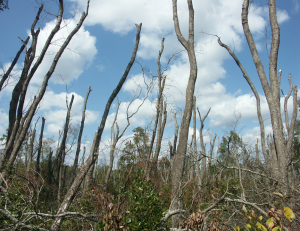
Mycorrhizal fungi (pictured in white and yellow) have a working relationship with tree roots. Photo by Indiana Unviersity.
Below the surface of the forest floor, tiny fungi in the soil are feeding on sugars in tree roots while also providing an important ecosystem service: helping trees absorb soil nutrients necessary for growth and survival. Researchers have found that certain types of these mycorrhizal fungi, as they are known, may also determine the forest’s risk of being invaded by nonnative plants.
“We discovered that forests dominated by arbuscular mycorrhizal (AM) fungi are more vulnerable to nonnative plant invasions. In these forests, AM fungi consume and recycle soil nutrients more rapidly compared to forests dominated by ectomycorrhizal (ECM) fungi,” says Kevin Potter, a North Carolina State University scientist cooperating with the Eastern Forest Environmental Threat Assessment Center and a coauthor of the study headed by scientists in the Natural Resources Spatial Analysis Lab at Purdue University.
The greater nutrition available to trees in AM fungi-dominated forests allows both native and nonnative plants to thrive, but nonnative invasive plants’ growth rate can be 12 times that of native plants in these forests. Managers can use this information to monitor and target efforts to control invasive plants.
“Where eastern U.S. forests are shifting from ECM-dominated oak-hickory forests to AM-dominated maple forests, managers should be on the lookout for more exotic plant invasions,” says Potter. Findings, published in Ecology Letters, are based on data from the Forest Service Forest Inventory and Analysis program.
For more information, see this news item from the U.S. Forest Service Southern Research Station and this news release from the U.S. Forest Service Northern Research Station.
December 1, 2017




